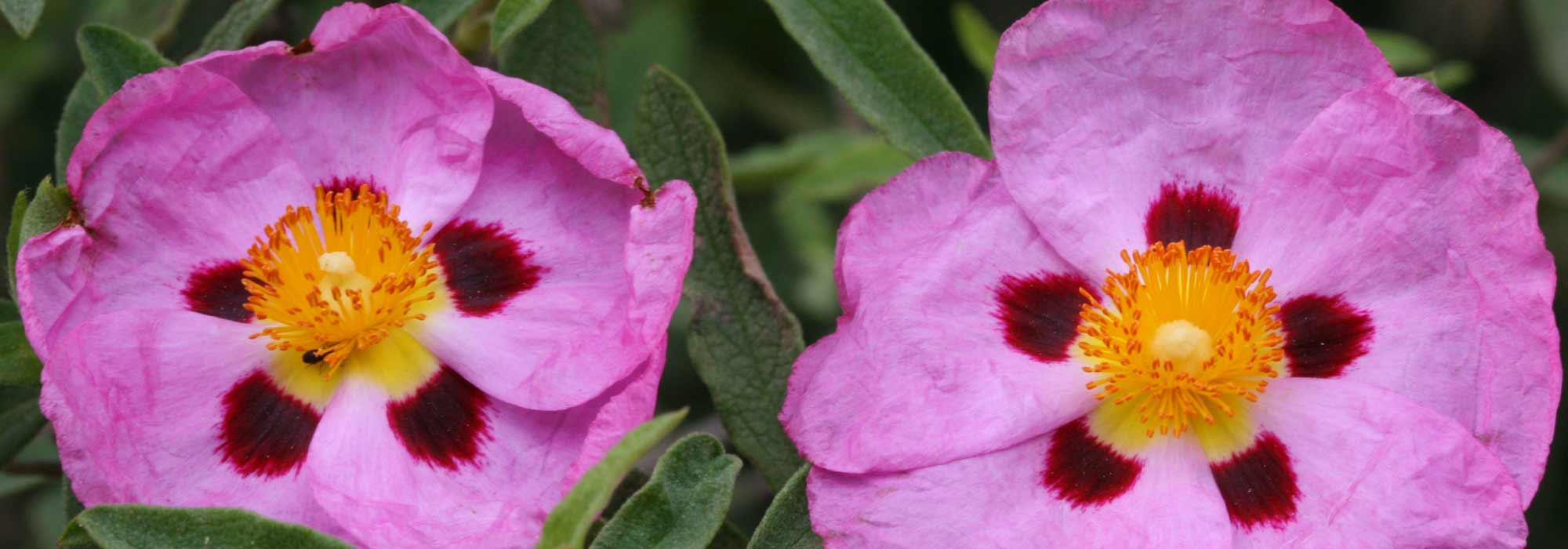
Cistus, rock rose: planting, pruning and care
Contents
Cistus in a nutshell
- Cistus is a must-have bush for Mediterranean gardens,
- It forms a very floriferous evergreen bush,
- Hardy down to -10°C, it is nevertheless reserved for mild climates,
- It grows in full sun and only in well-drained soil,
- Once well established in the sun, it requires no maintenance.
A word from our expert
Have you ever heard of Cistus? While for plant enthusiasts, it evokes small bushes that thrive in the garrigue, for others, it’s a treasure hunt with a map of cists (boxes containing treasures) in hand!
Cistus is a useful plant both in the garden and in medicine. It is a medicinal plant known for its essential oil from Cistus ladanifer, traditionally used for its healing properties.
From April to July, they bring freshness to a dry, unwatered garden with their crumpled pink or white flowers.
Cistus of Montpellier, white or purple cistus (Cistus x purpureus), the Cistus are handsome Mediterranean bushes perfectly adapted to drought, ideal in gardens spared from severe frosts. Elsewhere, they can be grown in large pots to be stored in winter in the conservatory or greenhouse.
Somewhat frost-sensitive but very floriferous, they thrive in stony gardens and arid soils, where few plants are willing to grow.
Cistus are rarely affected by diseases and once well established in the sun, in drained soil, they are quite undemanding.
With easy maintenance, planting, pruning, and propagation by cuttings, here are all the secrets to growing and keeping beautiful Cistus, these essential plants for the garden!
Description and botany
Botanical data
- Latin name Cistus
- Family Cistaceae
- Common name Rockrose
- Flowering April to July
- Height 0.30 to 2 m
- Exposure Sun
- Soil type Clay-loamy, stony well-drained
- Hardiness -10°C
The Rockrose is a typical Mediterranean bush belonging to the Cistaceae family and the Cistus genus, which includes around twenty species and numerous hybrid varieties. It grows spontaneously in dry, stony or rocky soils around the Mediterranean, where it roots thanks to its deep and ramified root system. It is widely found in the garrigues of southern France.
With a relatively slow growth rate, it forms small, bushy, highly branched plants about 0.30 to 1.50 m tall in all directions. Its bushy habit can be erect, stocky, or spreading. Depending on the species, it presents a regular dome shape in Cistus salviifolius, an upright form in Cistus populifolius, or a very spreading habit in Cistus x pulverulentus.
Its lifespan is quite short, averaging around ten years.
Its flowering is a delight! The foliage of the Rockrose disappears from early April to June-July depending on the climate, under a profusion of silky flowers, with well-opened round corollas, solitary or grouped in bouquets of two to six at the tips of the branches. Emerging from crumpled floral buds, these rose-like flowers bloom in crumpled cups, measuring 2 to 10 cm in diameter, mainly white or pink.
They consist of five petals wrinkled like tissue paper, sometimes adorned with beautiful contrasting macules that spread around a heart occupied by a pompom of golden-yellow stamens. Often white, they can take on a lovely rose-violet hue in the purple rockrose or Cistus (x) purpureus, or Indian pink in Cistus (x) pulverulentus ‘Sunset’, and cream yellow in Cistus x revolii ‘Merrist Wood Cream’.
Each flower lasts barely a day and wilts by late afternoon, scattering a shower of petals on the ground. While the flowers are ephemeral, the floral buds are countless, and they are replaced each morning by others throughout the flowering period. This constant renewal gives the bush an air of eternity for several weeks.

Melliferous, they particularly attract bees, butterflies, and other pollinating insects. Generally unscented, with the exception of a few rockroses like the Montpellier rockrose, they more than compensate for this lack of fragrance with their remarkable floribundity. After flowering, brown, pubescent globular capsules that retain the seeds for a long time appear.
The Rockrose forms beautiful bushy clumps interesting for their evergreen foliage, even if it is of lesser interest than the flowering. Its evergreen leaves, measuring 1 to 10 cm long, with sometimes undulating edges, are narrow, oval, round, elliptical, or elongated, depending on the varieties. The foliage of Cistus populifolius, also known as “Poplar-leaved Rockrose”, consists of large heart-shaped oval leaves, reminiscent of those of certain poplars. Green-grey and downy, those of Cistus salviifolius resemble those of common sage.
They bear often very marked veins making them look like a small basket, hence the name rockrose, meaning “basket” in Greek.
The young shoots are sticky and highly aromatic in hot and dry weather. They exude a very penetrating amber and spicy fragrance on a hot day.
The colour of the leaves varies according to the varieties, from shiny dark green to downy silver-green (Cistus albidus), passing through yellow or variegated in Cistus (x) corbariensis Rospico. Some have a lighter underside. A beautiful dark green in summer, they take on a lovely reddish-violet hue in winter in the Corbières rockrose.

Rockrose: flower, foliage, and seed capsules.
Since antiquity, an aromatic resinous substance, labdanum, has been extracted from the leaves and branches of Cistus ladanifer, widely used in perfumery and aromatherapy for its medicinal properties. In the garrigue, their leaves can ignite under very high temperatures due to the essences they contain. The Rockrose is a pyrophytic species whose germination is favoured by the passage of fire.
A plant of limestone garrigues par excellence, the Rockrose grows in stony and poor soils where water does not stagnate. This shrub, with exemplary frugality, is armed against drought and salty winds, loves full sun and warm, sheltered locations.
Semi-hardy, in well-drained soil it can withstand down to -10 or -15 °C. In regions north of the Loire, it is preferable to grow the rockrose in a pot and protect it from frost in winter.
In the garden, it can be used freely in beds, free hedges, borders, dry rockeries, to adorn a dry and poor bank or even on a sunny terrace or balcony.
Species and main varieties
The genus Cistus includes around twenty species and numerous interesting hybrid varieties with varying sizes (from 0.50 m for the ground cover species to about 2 m for the largest) and flower colours. They are typically classified into two categories: white-flowered Cistus and pink-flowered Cistus.
Not all offer the same hardiness. Among the hardiest are Cistus salviifolius, the Cistus of the Corbières, and Cistus x pulverulentus, which can withstand temperatures down to -12°C, even -15°C, in well-drained soil and in a sunny, sheltered position. The Cistus of Crete is more sensitive to frost (-8°C).
The choice of a Cistus depends on the intended use: in borders, in pots, or as ground cover.
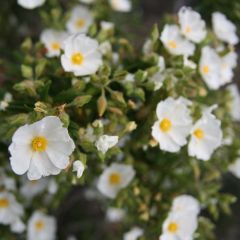
Cistus monspeliensis - Montpelier Rockrose
- Flowering time May to July
- Height at maturity 70 cm
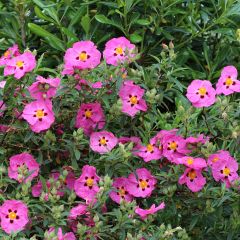
Cistus x purpureus - Rockrose
- Flowering time May to July
- Height at maturity 1 m
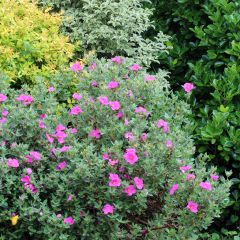
Cistus pulverulentus Sunset - Rockrose
- Flowering time July, August
- Height at maturity 50 cm
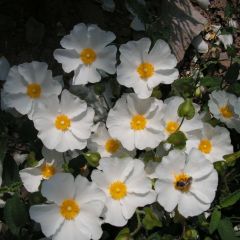
Cistus x corbariensis - Rockrose
- Flowering time May to July
- Height at maturity 70 cm
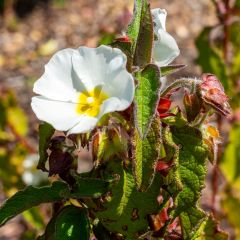
Cistus populifolius - Poplar-leaved Rockrose
- Flowering time May to July
- Height at maturity 2 m
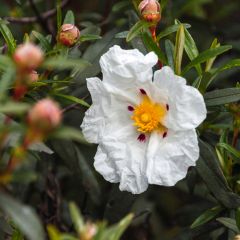
Cistus x loretii - Rockrose
- Flowering time May to July
- Height at maturity 90 cm

Cistus salviifolius - Rockrose
- Flowering time May to July
- Height at maturity 90 cm
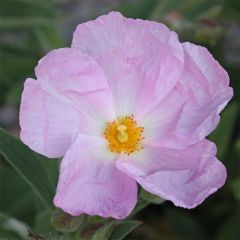
Cistus x argenteus Peggy Sammons - Rockrose
- Flowering time June, July
- Height at maturity 1,20 m
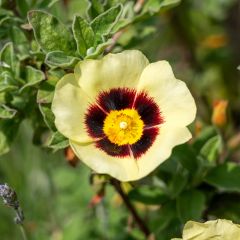
Halimiocistus wintonensis Merrist Wood Cream
- Flowering time June, July
- Height at maturity 60 cm
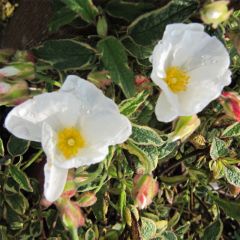
Cistus x corbariensis Rospico - Rockrose
- Flowering time May to July
- Height at maturity 70 cm
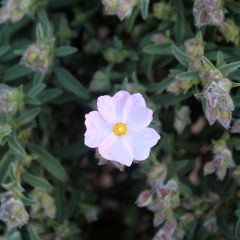
Cistus x skanbergii - Rockrose
- Flowering time May to July
- Height at maturity 60 cm
Discover other Cistus - Rockrose
View all →Available in 1 sizes
Available in 2 sizes
Available in 2 sizes
Available in 1 sizes
Available in 0 sizes
Available in 1 sizes
Available in 1 sizes
Available in 1 sizes
Available in 1 sizes
Available in 1 sizes
Planting
Where to plant Cistus?
Cistus is a bush typical of Mediterranean scrub that grows on its own in dry and hot climates. It does not tolerate overly humid regions well, but its foliage withstands the sea spray from coastal areas.
Provide it with sunlight, plenty of heat, and a sheltered spot from strong winds. Below the Loire, it can be grown in open ground; however, for regions further north, growing in large pots is preferable.
With average hardiness, it is particularly sensitive to wet frost beyond -5°C to -10°C. In well-drained soil, it shows greater resistance to cold. Place it in the warmest corner of the garden, in full sun against a south-facing wall. Some dry woodland species like Cistus salviifolius are distinguished by their tolerance to shade and root competition.
It prefers stony or sandy soils where water does not stagnate. It is particularly averse to heavy, compact, suffocating soils in which it will not survive.
Cistus can be used as a solitary plant or in groups. It is not very space-consuming. However, due to its relatively slow growth, avoid unnecessary relocation to allow it time to settle. It can be used in borders, rockeries, or as ground cover along pathways or stairs. In regions with harsh winters, growing in large pots is possible.
When to plant a Cistus?
Planting of the Cistus should be done after the last frosts, in April-May north of the Loire, and in September-October in hot and dry climates.
How to plant Cistus?
If your soil retains moisture, plant your Cistus on top of a mound, where water will not stagnate. For group planting, space the plants about 0.40 to 1 m apart depending on the varieties.
- In open ground
- Dig a hole 2 to 3 times the volume of the pot
- Make a gravel bed at the bottom of the hole
- Plant the bush at collar level
- Add coarse sand
- Fill the hole
- Keep the bush upright
- Lightly compact with your foot
- Mulch the base
- Water generously at planting, then sparingly during the first year, allowing the soil to dry out between waterings
- Afterwards, only water in case of prolonged heat
In pots
The substrate must be very draining to avoid stagnant moisture. Place it in full sun in a large pot of at least 50 cm in diameter.
- Spread a good layer of drainage (gravel or clay balls)
- Plant in a sandy soil mix
- Mulch the base
- Water abundantly but not too often, allowing the substrate to dry out between waterings
- In summer, water as soon as the surface soil is dry
- Bring the pot indoors to protect it from frost as soon as the first chills arrive in cold regions and reduce watering
→ Learn more in our advice sheet: Planting a Cistus in a pot
Maintenance and care
Cistus is a low-maintenance bush and when well established in perfectly drained soil, it offers better hardiness.
Perfectly suited to sun and drought, it withstands long periods of aridity well.
- In open ground, once well established, only water in case of prolonged drought.
- Potted cistus requires more regular watering: in summer, water when the soil is dry and allow the substrate to dry out between waterings.
- In winter, if severe frosts are forecast, protect your bush with a winter cover. Mulch the base of the most frost-sensitive varieties (Cistus salvifolius) to insulate them from the cold as much as possible.
- Store potted cistus in a frost-free place in regions where temperatures regularly drop below -10°C.
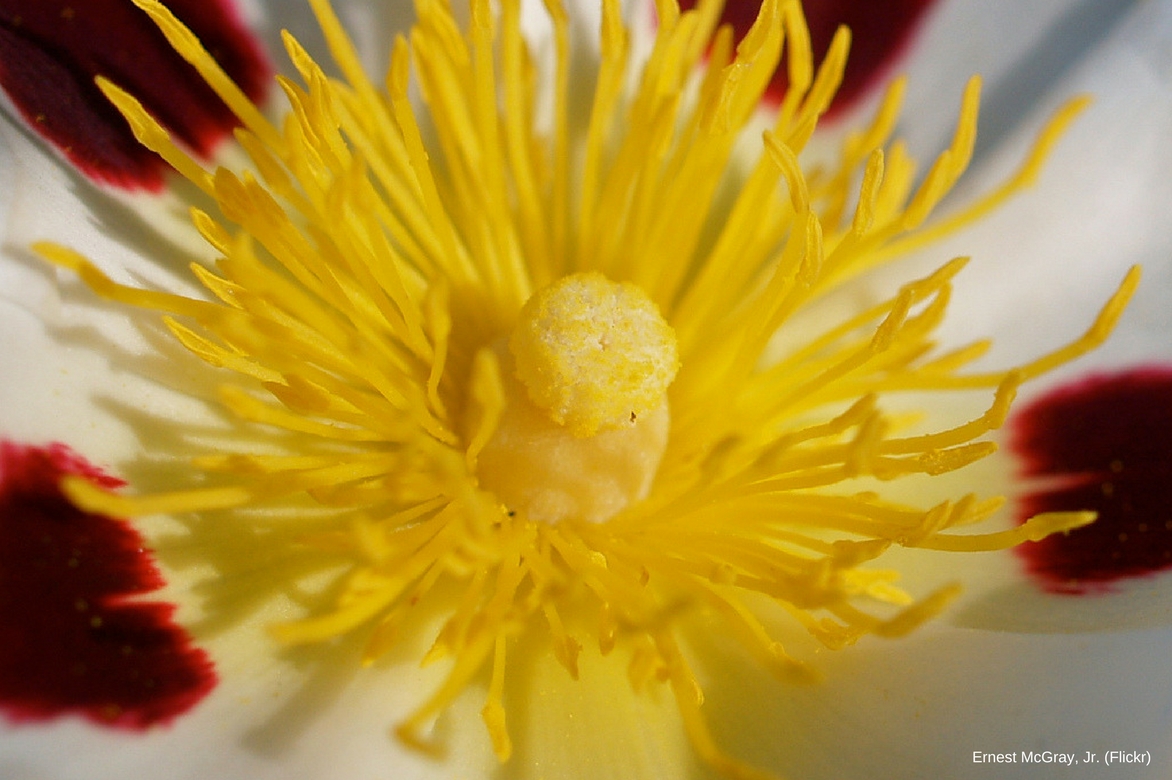
When and how to prune cistus?
Pruning of Cistus is not necessary. Cistus does not respond well to drastic pruning, it is preferable to replace old, bare specimens. Only intervene to remove any dead branches or to carry out a very light refresh to maintain a balanced and bushy habit.
After flowering, simply cut (pinch) the last third of the branches to encourage the plant to ramify and remove dead wood.
Diseases and potential pests
Behind its fragile flowers lies a solid temperament and a robustness that can withstand anything. The Cistus is a tough plant not prone to diseases or pests. It only fears two things: cold and moisture.
It can sometimes suffer from fungal infections caused by heat combined with humidity. It is occasionally colonised at its base by Cytinus, a small parasitic plant with yellow flowers.
In cases of excess lime, it may show signs of chlorosis over time in very chalky soil.
Multiplication
If Cistus is propagated by sowing under a cold frame in autumn or spring, the quickest technique is propagation by cuttings, which should be reserved for experienced gardeners.
- At the end of summer, take heel cuttings 10 cm long from non-flowering stems
- Insert them into a mixture of sand and potting soil kept slightly moist
- Place under a heated frame
- As soon as they produce roots, transplant the cuttings into a very sandy mixture
- Transplant into open ground the following spring
Discover our tips for successfully propagating Cistus cuttings and our tutorial How to sow Cistus?
Associating
A must-have for dry, water-free gardens, Rockrose brings color, density, and brightness to flower beds, borders, and rock gardens. It thrives beautifully in a garden alongside other Mediterranean shrubs or sun-loving perennials
In an evergreen bed qui fleure bon la garrigue, entourez-le de lavenders, santolines, de romarins rampants, d’un Teucrium fruticans ‘Azurea’, de vivaces aromatiques telles que thyms et sage. Pour dynamiser la scène, associez-y des hélianthèmes, des California poppies, népétas, ballotes et des euphorbes de terrain sec (E. Characias Black Pearl).
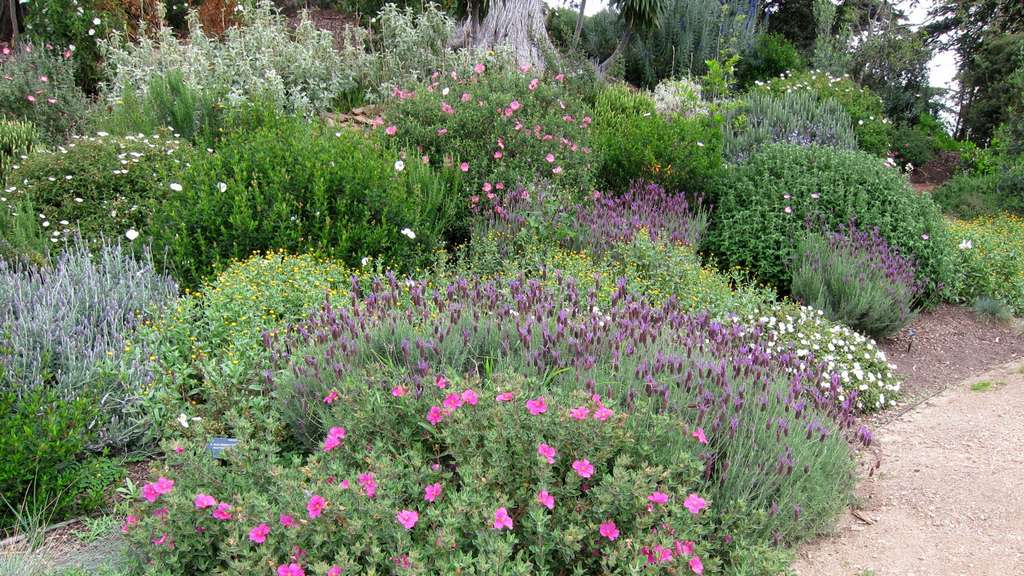
Cistus x pulverulentus ‘Sunset’, Cistus salviifolius ‘Prostratus’ et Lavandula stoechas au San Francisco Botanical Garden à Heidelberg Hill (Cultivar413-Flickr)
The pink-flowered Cistus s’harmonise bien avec les petites fleurs cramoisies d’un Leptospermun scoparium. Dans un massif foisonnant au cœur de l’été, il se marie agréablement avec les œillets mignardises, les chardons bleus, les gypsophiles précoces, les summer alliums et les nigellas.
The white-flowered Cistus voisine bien avec les armoises entouré d’un Ceanothus thyrsiflorus ‘Millerton Point’. Il sera le compagnon idéal des Phlomis samia, des Acanthus et du Geranium macrorrhizum.
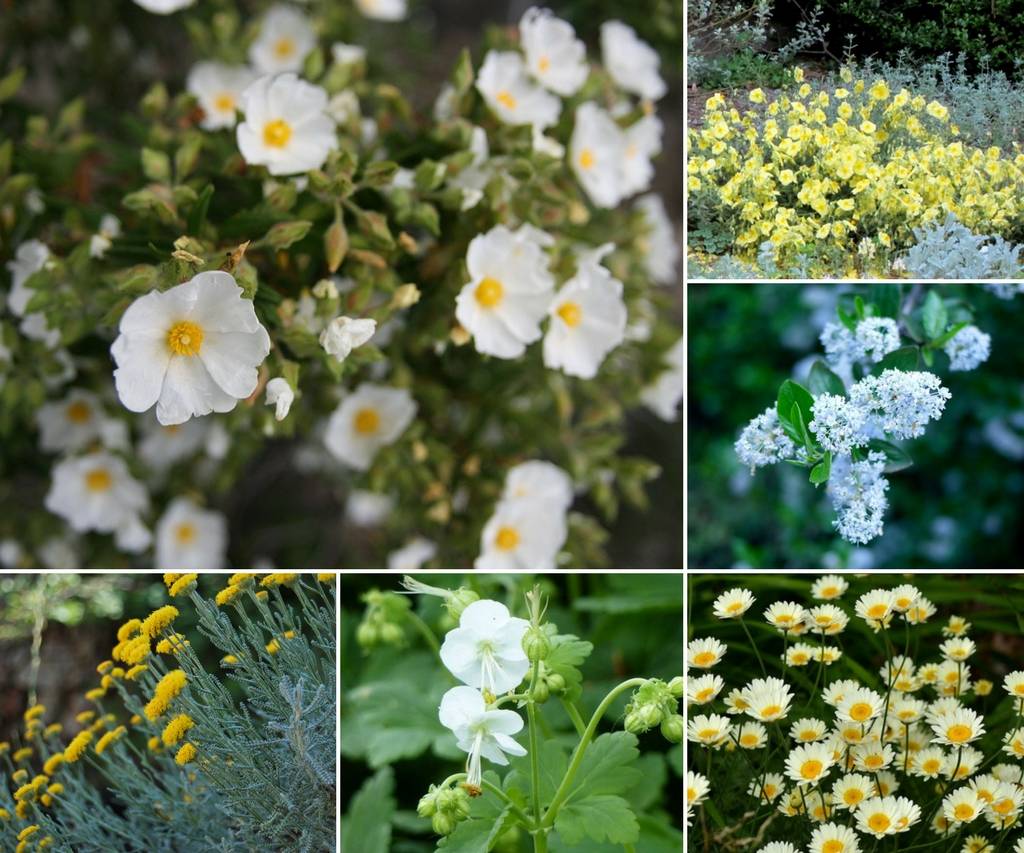
Un exemple d’association tout en nuances de blanc, de jaune et d’argenté : Cistus monspeliensis, Helianthemum ‘Wisley Primrose’ et d’armoises (Artemisia ‘Powis Castle’, ‘Silver Queen’, ‘Valérie Finnis’…), Ceanothus thyrsiflorus ‘Millerton Point’, Santolina chamaecyparissus, Geranium macrorrhizum ‘White Ness’ et Anthemis tinctoria ‘Sauce Hollandaise’.
Le Ciste produira son plus bel effet en premier-plan d’une composition plus exotique, entouré d’un Melaleuca gibbosa, d’un Callistemon rigidus, d’une Grevillea rosmarinifolia.
Useful resources
- Dive into the heart of Corsican scrub vegetation and discover its botanical beauties!
- Our advice sheets: Choosing a cistus, Sowing cistus, and Associating cistus
- Discover other allelopathic plants!
- Our advice sheet: Planting a cistus in a pot
- Subscribe!
- Contents


































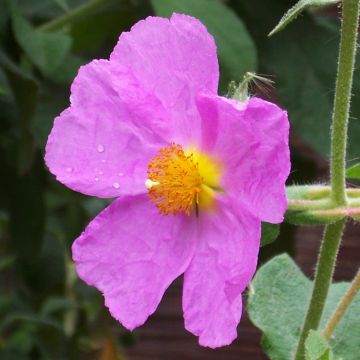
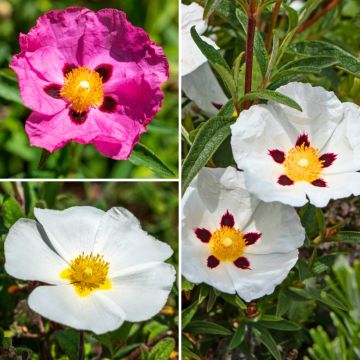


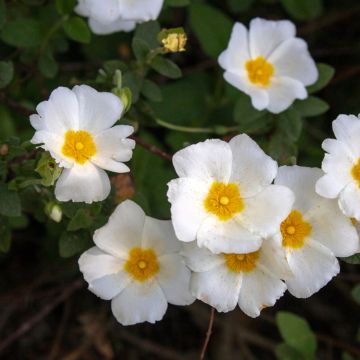

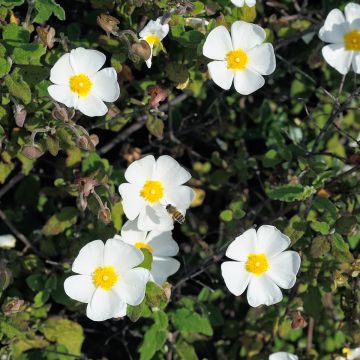
Comments